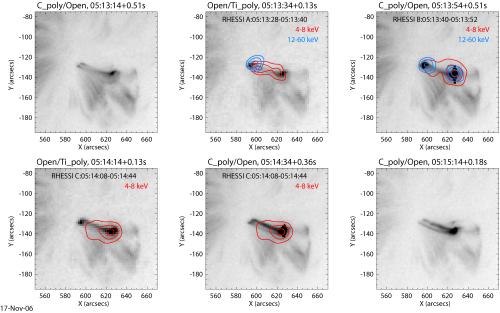A hard wee flare observed with RHESSI and Hinode/XRT
| Nugget | |
|---|---|
| Number: | 70 |
| 1st Author: | Iain Hannah |
| 2nd Author: | |
| Published: | 25 January 2008 |
| Next Nugget: | Acceleration of fast halo CMEs & synchronized flare HXR bursts |
| Previous Nugget: | Annealing RHESSI for the first time |
Introduction
As was discussed in previous Nuggets, RHESSI and the soft X-ray telescope XRT on the Hinode satellite have provided X-ray observations that are ideal for comparison. RHESSI's imaging and spectroscopy capabilities allow it to determine where the accelerated electrons deposit their energy and the characteristics of this energy deposition. Hinode/XRT's high spatial resolution and sensitivity to softer X-rays make it ideally suited to observe the dynamics of the resulting plasma heating and evaporation. RHESSI also provides spatial and spectral information about the higher temperatures (>20MK) in the flaring plasma. So in this Nugget we look at this comparison for a small well-observed microflare (see here for details).
RHESSI lightcurves
To investigate the particle acceleration and heating in a microflare with both RHESSI and Hinode/XRT we need an event with good coverage in both instruments, and a clear hard X-ray signal in RHESSI. Such an event, at GOES A7 (A2) class, occurred at 05:13 UT on November 17, 2006, and the RHESSI lightcurve for this microflare is shown below in Figure 1.

There are two remarkable things about this microflare: its high energy X-ray emission, and its low-energy X-ray time profile. Microflares are rarely seen above 25 keV with RHESSI but this little flare has emission extending beyond 50 keV! Out of over 25,000 other microflares studied with RHESSI no other had a spectrum as hard/flat as this one, to energies above 50 keV. The events that come closest are from the same active region (NOAA AR 10923), which for some unknown reason was particularly efficient at accelerating electrons to these energies in these small flares. So this microflare certainly provides a unusually clear hard X-ray signal of the non-thermal emission.
But there is also something interesting in the low-energy emission RHESSI observed. Normally the microflare emission in 4-8 keV is predominantly thermal, but if this were the case then the 4-8 keV time profile should match the time-integrated profile from the higher-energy, non-thermal emission. This deviation from the Neupert effect, shown by the blue overplotted curve in Figure 1, suggests that this initial burst of 4-8 keV emission might not have been thermal in nature. The presence of the Fe K-shell lines at around 7 keV in the RHESSI spectrum would have been a clear signature of a hot thermal component, but unfortunately this event occurred before the successful anneal, and so the line feature could not be distinguished from the continuum.
RHESSI & Hinode/XRT Imaging
RHESSI images were generated for three time periods during the microflare in a thermal band, 4-8 keV, and a non-thermal band, 12-60 keV, and then compared to the XRT images as shown in Figure 2.

The RHESSI footpoints match spatially and temporally with points of bright emission in XRT, suggesting that the accelerated electrons are depositing their energy and also heating the plasma. Subsequently hot emission is seen along the loops connecting these footpoints, in both XRT and RHESSI. However the high spatial resolution of XRT shows that there are at least two loops, whereas the RHESSI images alone suggest only a single loop. This is consistent with the angular resolutions of the two telescopes.
An intriguing event to start with!
This is quite a remarkable microflare because of its very hard/flat spectrum to above 60 keV, and its unexpected time profile at low energies. The combined use of RHESSI and Hinode/XRT provides us with a deeper insight to what might be happening but still leave some puzzles. The continued use of RHESSI and Hinode/XRT to explore the X-ray emission in microflares, especially a statistical sample of events, should (we hope) help resolve some of these puzzles and probably present even more.
Biographical note
Iain Hannah is a member of the RHESSI team at Space Science Lab, UC Berkeley.